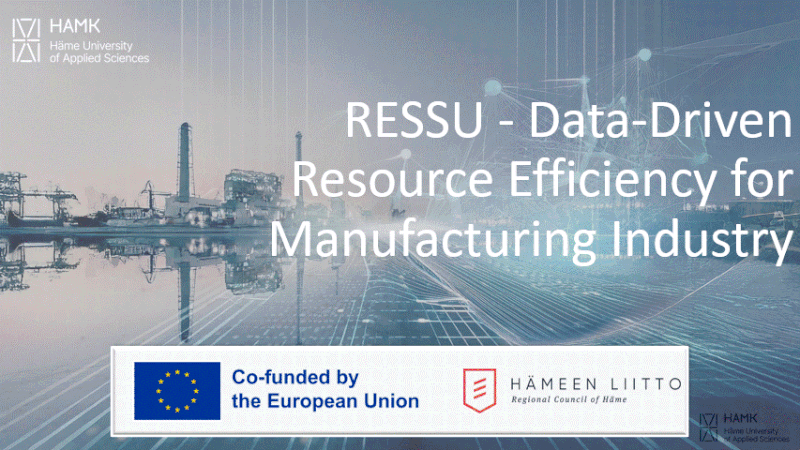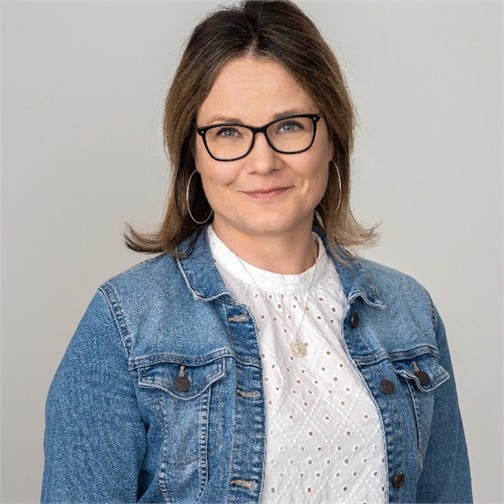

RESSU
Data-driven resource efficiency in manufacturing industries

Project information
| Project | Data-driven recource efficiency in manufacturing industries – RESSU (A81610) |
| Duration | September 1, 2025 – August 31, 2027 |
| Partners | Häme University of Applied Sciences |
| Funders | European Regional Development Fund |
| Budget | €214,309, of which EU funding covers €150,000 |
The goal of the RESSU project is to examine the costs of wasted resources in small and medium-sized enterprises using data and to encourage companies to take development actions to save resources.
Mitigating climate change requires changes in energy- and emission-intensive industries. Emissions can be reduced by using resources more efficiently. The waste hierarchy advises that the primary focus should be on reducing the amount of waste generated, making it natural to concentrate on minimizing waste in small and medium-sized enterprises (SMEs) and exploring the potential of industrial symbioses created through cooperation between companies.
In manufacturing, preventing the generation of waste and losses is possible when the processes and stages that cause waste are identified and the related costs are taken into account. Waste, losses, and other surplus resources can be transformed into valuable inputs for another company through industrial symbioses. To enable the efficient reuse of resources, it is essential to have information about their existence, availability, and characteristics. This is where the RESSU project comes in: the project examines the costs of wasted resources in companies using data, thereby motivating them to recognize and reduce waste and to take action toward improvement. The reuse of resources is also explored through local business development organizations and the national FISS network, as well as by utilizing digital platforms such as Materiaalitori. Potential industrial symbioses are modeled and simulated to assess their feasibility and benefits.
For companies, more efficient use of resources generates economic, social, and environmental benefits. Reducing waste and losses lowers material costs, which improves profitability. Increased profitability can create new jobs and help secure existing ones. Environmentally, the project contributes to reducing the use of natural resources and emissions.
Target group
The target group of the RESSU project consists mainly of small and medium-sized manufacturing companies in the Tavastia Proper region. Large companies can also be involved in developing the industrial symbiosis ecosystem.
Operating area
The RESSU project operates in the Tavastia Proper region
Objectives
1.) Reduce waste and losses in companies.
The project helps companies use raw materials and energy more efficiently to minimize unnecessary waste and losses.
2.) Encourage collaboration between companies in sharing resources.
Companies can utilize each other’s side streams and materials, enabling smarter and more environmentally friendly use of resources.
3.) Share knowledge and best practices.
The project disseminates information, examples, and insights on how companies can develop their operations to become more sustainable and efficient.
Implementation: Work Packages
The project is carried out in cooperation with small and medium-sized enterprises in the Tavastia region. The activities are divided into three work packages (WP), which focus on improving resource efficiency, developing industrial symbioses and sustainable material management through data, and strengthening communication and international networking.
The work package identifies companies’ development areas and existing data, conducts resource assessments to determine the mechanisms behind waste and loss generation, and calculates the related costs. In addition, resource-saving production methods and smart material management practices are developed in collaboration with company personnel to reduce waste and losses.
The work package promotes industrial symbioses by applying the FISS model to enable the reuse of resources, side streams, and waste between companies. In addition, workshops are organized to identify synergies and assess their implementation potential, a digital platform is tested for finding symbiosis partners, and digital simulations and sustainable logistics concepts are developed.
The work package focuses on the project’s communication and visibility among companies, as well as on information sharing and campaigning related to reducing waste and losses. In addition, six publications will be produced during different phases of the project, companies will receive advisory services and training based on the project’s results, and international benchmarking and networking will be carried out during the two years of project implementation.
Brief project presentation


The project gained visibility on LinkedIn.
Check out the project’s LinkedIn update – click the link below to read more.
Only in Finnish

The project announcement is now available.
The project announcement has been published! Click the link below to learn more.
Only in FInnish

What exactly is a FISS network?
The project addresses FISS networks – but what are they? Read more by clicking the link below.
Only in FInnish
Follow us on social media!
Check out HAMK’s social media channels focusing on research!
Contact information
Project Manager: Anne-Mari Järvenpää

Anne-Mari Järvenpää
Principal Research Scientist, tenure track

